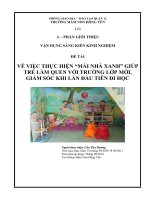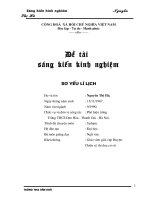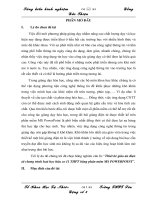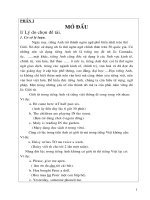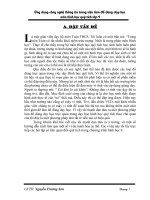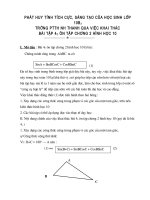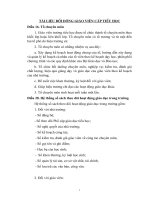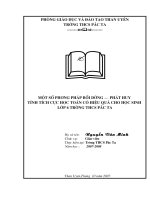SÁNG KIẾN KINH NGHIỆM APPLYING SOME STRATEGIES FOR TEACHINGLISTENING LESSONS IN GRADE 12
Bạn đang xem bản rút gọn của tài liệu. Xem và tải ngay bản đầy đủ của tài liệu tại đây (402.9 KB, 19 trang )
SỞ GIÁO DỤC VÀ ĐÀO TẠO THANH HÓA
TRƯỜNG THPT YÊN ĐỊNH 2
SÁNG KIẾN KINH NGHIỆM
APPLYING SOME STRATEGIES FOR TEACHING
LISTENING LESSONS IN GRADE 12
Người thực hiện: Lê Đức Cảnh
Chức vụ: Giáo viên
SKKN thuộc lĩnh vực: Tiếng Anh
THANH HÓA NĂM 2014
1
PART A: INTRODUCTION
1. Reason for choosing the study
Skills of listening have been neglected in terms of research and shifted to
a secondary position. The priority has been given to teaching speaking and
writing. It is a surprising fact considering that it is the skill most often used in
everyday life. According to L. Miller (2003), more than forty percent of our
daily communication is spent on listening, thirty-five percent on speaking, about
sixteen percent on reading, and only nine percent on writing. Yet listening
remains one of the least understood processes in language learning in spite of its
critical role in communication and language acquisition.
Researchers and language teachers have often maintained that listening
skills could be picked up by the learners. Now it is generally accepted that
listening skills have to be taught like any other language skills. Currently more
attention is being paid to developing and researching the field of teaching
listening.
In high schools, students are often afraid of learning listening lessons for
some reasons such as the dull lectures, the unsuitable level lessons, irrelevant
strategy listening, unclear sounds in tapes…This leads to their nervousness
during listening lessons and they can hardly listen to anything which causes the
bad result in learning the listening skill.
From my experience in teaching English at Yen Dinh 2 school I realized
that the well – prepared lesson plans in which teacher simplify the tasks and use
strategies helps the students have better results in listening lessons. That why I
choose the theme “Applying some strategies for teaching listening lessons in
grade 12 ”
2. Objectives of the study
The objectives of this research is to simplify the tasks and use strategies in
listening lessons in English textbook 12 to have effective lectures and develop
student’s listening skills
2
3. Scope of the study
This study is conducted among the 12
th
form students at Yen Dinh 2 high
school during the school year 2013- 2014
4. Methodology of the study
Both comparative and contrastive methods are used. For the theoretical
basis, a lot of reference materials on listening skills have been collected,
analyzed and synthesized carefully with the due consideration for the students’
learning situations.
5. Significance of the study
This study may provide insights into the process of learning the listening
skill for the students. It motivates the students’ desire for learning English, and
make them more confident and active in listening activities. It also gives some
suggestions for other teachers for teaching listening lessons
3
PART B: CONTENTS
1. Theoretical background of the listening skill
1.1. What is the listening skill?
So far, there have been a number of definitions of listening by different
linguists such as Howatt and Dakin (1974); Wolvin and Coakley (1982);
Pearson (1983);
Howatt and Dakin (1974) defined listening as the ability to identify and
understand what others are saying. This involves understanding a speaker's
accent or pronunciation, his grammar and his vocabulary, and grasping his
meaning.
Wolvin and Coakley (1982) regarded listening "the process of receiving,
attending to and assigning meaning to aural stimuli".
Pearson (1983) stated “Listening involves the simultaneous organization
and combination of skills in Phonology, Syntax, Semantics, and knowledge of
the text structure, all of which seem to be controlled by the cognitive process.
Thus it can be said that though not fully realized, the listening skill is essential in
acquiring language proficiency”.
1.2 The importance of listening
Language skills are often integrated with each other in language use. This
is true with listening and speaking, so in conversations, two or more people
alternate speaking and listening. Like reading, listening is a receptive skill
where the purpose is to comprehend or understand what someone might be
saying or writing. It is an important, active skill of spoken language as it
involves various kinds of the listener's knowledge: knowledge of phonology,
vocabulary, semantics of the language in use, culture of its people, his life,
experience in the topic, his ability to predict and respond, etc. It decides his
comprehension, content and attitude in response to the speaker's speech as well.
In learning English as a foreign language, students cannot develop
speaking listening skills unless they develop listening skills. To have a
4
successful conversation, they must understand what is said to them. Later on,
the ability to understand the native speaker in direct conversations, on the radio
or tape may be very important for them to further study the language and
communicate in it. Finally, listening to spoken language is an important way of
acquiring the language or "picking up" vocabulary and structures.
1.3. Phases in the listening learning process
A listening text may be a short story, dialogue, piece of news, etc. Teaching a
listening text can be divided into three main stages: pre-listening, while -
listening, and post-listening. Each stage has its own aims and activities.
1.3.1 Pre-listening
This stage is aimed at preparing students with everything necessary for
listening and understanding the listening text. Some activities are:
Warming up the class: The teacher may motivate the class, gradually setting
up a context for the listening text to be presented by asking questions to elicit
students' experience, or ideas concerning the coming text or by using some
sort of visual aids or their imagination.
Introducing the topic of the listening text. Tile teacher briefly introduces the
topic of the listening text so that the students may get their mind ready for it.
Presenting key words. The teacher only presents any word that is necessary
for students to understand the text.
Giving guiding questions: These guiding questions will help focus the
students' attention on the main points of the text. They will guide the students
to the better understanding of the text. Students should be allowed to make
guesses at the answer to the questions before listening.
1.3.2 While-listening .
The aim of this stage is to facilitate students' listening and check their
comprehension. While the students are listening to the text for the first time,
they can check their guess at and give the correct answer to the guiding
questions. The teacher then gives the students some tasks to do while they are
5
listening for the second time. They can do some of the activities such as: gap-
filling, true or false statements, answering comprehension questions, matching,
multiple choice, reordering, etc. The students may need to listen to the text
more than once so that they can finish their while-listening activities. After
checking the students' answers, the teacher should emphasize the key points of
the text and explain the difficulties in vocabulary or structures that the students
encounter while listening. Be sure while listening, students are not allowed to
look at the tape script of the listening text.
1.3.3 Post-listening
At this stage, students can have opportunities to practise using what they have
got from the listening text. Students can do such activities as: '
• Summarizing the text orally or in written form.
• Re-telling the content of the listening text.
• Role play: Students play the roles of the characters in the text.
• Discussion: Students can discuss the points in the listening text or giving
their comments about the information in the text.
The teacher should make up and vary the activities for students to do at this
stage depending on their level of English.
2. Some strategies in teaching listening lessons grade 12
In the English 12 textbook, most of the listening lessons have pictures to
exploit the related contents, some tasks in“ While you listen” are quite relevant,
however, there are some lessons have no pictures but have quite difficult tasks,
For the limit of my theme I only focus on unit 2, unit 6 as examples and give
some suggestions which I find them effective
2.1 WARM UP. ( 5 minutes)
Besides using the pictures, handouts, I prepare some games for this parts
(“Hangman, brainstorming” …) to save time to lead students to new lessons
easily from the start
6
- For example:
Unit 2: CUTURAL DIVERSITY
PERIOD 8: LESSON 3 – LISTENING
The purposes of this lesson is to provide the listening comprehension
about the wedding ceremony in Vietnam. The topic is very popular however,
students will have difficulties in listening because the vocabulary is unfamiliar
and two voices in tapes are similar. So I combine games Brain Storming and
some open questions to lead to the topic
Teacher’s and Students’activities Contents
A. Warm up: Game: Brain
Storming
- T guides Ss how to play the game
- Ss listen and start playing the game
- T asks Ss some questions about the
picture (page 24)
- Ss listen and answer the questions.
- T remarks and introduce the lesson
Suggested answers
- bride
- groom
- party
- pray
Questions:
1. Have you ever attended a wedding
ceremony ?
2. What do the bride and the groom
usually do at the wedding ceremony?
Answers:
1. Yes/ no
2. They stand in front of the altar
praying and asking their ancestor’s
permission to be married. They
7
wedding
exchange their wedding rings.
►Wedding ceremony is one of the most
important in one's life. I am sure that all
of you have attended this event a lot.
Today we will listen to a Vietnamese
Wedding in English.
Unit 6: FUTURE JOBS
PERIOD 33: LESSON 3 – LISTENING
The purposes of this lesson is to provide listening comprehension about
the American work force, the distribution and change of chosen jobs from the
past to the future, the topic of this lesson is not easy because the vocabulary is
difficult. So I do “Warm up” as following
- Look at the pictures and give the names of the jobs or services
Expected answers: 1. tailors
2. staff car/ motorbike washing
3. vendor/ seller
4. accountant/ accounting
5. teacher/ education
6. transportation
-Teacher ask students to list some more
8
1. Beside these jobs, Can you make a list of some other jobs?
- Teacher lead students to 2 group jobs
+ Manufacturing jobs : tailors/ car makers ….
+ Service jobs : seller/ accounting/ transportation ….
2. In your opinion, Which is the most popular job in Vietnam?
from the answers of students .Teacher lead in the topic ►listening
lesson today is about the job market in the US.
2.2. BEFORE YOU LISTEN. ( 10 minutes )
This is an important step so as to provide students with some vocabulary
and related background. In “Warm up” part I also introduced some key
vocabulary altar praying, ancestor, exchange… to help students for my next
activities and I do as follow
Unit 2: CUTURAL DIVERSITY
PERIOD 8: LESSON 3 – LISTENING
♣ Activity 1: Matching (Match the question with its appropriate answer.
Aims: to elicit students' background knowledge and introduce some new words
Questions Answers
1. Who involves in the wedding?
2. What do all of them take part in?
3. What kind of food and drinks are
served in the wedding?
4. Where can the wedding be held?
5. Who is in charge of the ceremony?
6. Where does the MC start his work?
7. What is the altar used for?
8. What can be seen on the alter?
9. What does the couple do in front of
the altar?
10. What do the guests bring for the
couple?
a. envelops containing wedding card
and money, blessing, gift
b. At home, hotel, restaurant, or church
c. Master of Ceremony
d. In front of the altar
e. traditional food, wine, beer
f. to memorialize the ancestor
g. tray of fruit, photos, gift
h. pray, ask ancestors' permission,
exchange rings
i. Bride, groom, relatives, friends,
neighbors
k. The wedding banquet
Expected answers:
9
1 – i 2 – k 3 – e 4 – b 5 – c 6 – d 7 – h 8 – g 9 – h 10 - a
♣ Activity 2: Listen and repeat and make students get familiar with these
words in conversation
Unit 6: FUTURE JOBS
PERIOD 33: LESSON 3 – LISTENING
- From “Warm up” part I have introduced:
+ Manufacturing jobs : tailors/ car makers ….
+ Service jobs : seller/ accounting/ transportation ….
I lead students to understanding that manufacturing and service jobs
make “ workforce”
- From the pictures I provide the vocabulary vendor/ seller (n) from
here I lead students to the words “wholesale” and “retail”
2.3. WHILE YOU LISTEN ( 25 minutes )
Unit 2: CUTURAL DIVERSITY
PERIOD 8: LESSON 3 – LISTENING
Task in textbook Simplify the task
Task 1 - Listen to the passage and
fill in the missing information.
1. The wedding day is carefully
chosen by the …………
2. The gifts are wrapped in
…………
3. The wedding ceremony starts in
front of the ………………
4. Food and drinks are served
…………
5. The guests give the newly wedded
couples envelope containing
……….and ………
Task 1 - Listen and choose the best
answer as following sentences
1. The wedding day is carefully chosen
by the …………
A. groom's father only
B. bride's parents
C. groom's parents
D. both groom's and bride's parents
2. The gifts are wrapped in …………
A.bad paper B. blue paper
C. white paper D. red paper
3. The wedding ceremony starts in front
of the …………
A. church B. altar
10
Task 2 - Listen again answer the
questions.
1. What is the most important thing
the groom's family has to do on the
wedding day?
2. What would the groom and the
bride usually do during the wedding
ceremony?
3. When do the groom and the bride
exchange their wedding rings?
4. Where is the wedding banquet
usually held?
5. What do the groom, the bride and
their parents do at the wedding
C. restaurant D. hotel
4. Food and drinks are served …………
A. at the wedding banquet
B. at the restaurant
C. at groom's and bride's home
D. in front of the church
5. The guests give the newly wedded
couples envelopes containing
……….and ………
A. postcard and money
B. money and wedding cards
C. wedding cards and postcards
D. money and some red papers
Expected answers:
1C 2D 3B 4A 5B
Task 2 - Listen again and choose the
best answer for the following
questions.
1. What is the most important thing the
groom's family has to do on the wedding
day?
A. To go to the bride’s house bringing
gifts wrapped in red paper
B. To stand in front of ancestors's altar
praying and asking for groom's and
bride's love.
C. To choose the people who will
accompany the groom bringing gifts to
the bride 's house.
11
banquet? 2. What would the groom and the bride
usually do during the wedding
ceremony?
A. They would hold their hands
B. They would pray and ask their
ancestors’ permission to get married.
C. They would talk with their friends
and relatives
3. When do the groom and the bride
exchange their wedding rings?
A. Right after groom's family brings
gifts to the bride's house.
B. After they pray and ask their
ancestors’ permission to get married.
C. While they are praying and asking
their ancestors’ permission
4. Where is the wedding banquet usually
held?
A. at the groom’s and bride’s home
B. at a hotel or a restaurant
C. Both a and b are correct
5. What do the groom, the bride and
their parents do at the wedding
banquet?
A. Give the advice to the others
B. Drink wine and eat too much with
their guests
C. Stop by each table to thank their
guests.
Expected answers:
12
1c 2d 3b 4a 5b
Unit 6: FUTURE JOBS
PERIOD 33: LESSON 3 – LISTENING
Task in textbook Simplify the task
Task 2: Listen again and decide
whether the statements are true (T)
or false (F).
Statements T F
1. American workers have
changed from
manufacturing jobs to
service jobs.
2. Manufacturing jobs are
jobs in which workers make
something.
3. Personal services are one
of the five service jobs.
4. 70% of workers produced
goods one hundred years
ago.
5. 80% of workers will
work in the service sector
by the year 2020.
Task 2: Listen again and choose the
best answer
1. American worker have changed
__________________
A. from manufacturing jobs to service
jobs.
B. from service jobs to manufacturing
jobs.
C. Into manufacturing jobs.
2. ____________are jobs in which
people make something or produce
things
A. Service jobs
B. Manufacturing jobs
C. personal services
3. Generally, service jobs are grouped
into ______categories
A. four B. three C. five
4. One hundred years ago, _____ of
workers produced goods
A. 18 % B. 80% C. 30%
5. By the year 2020, __________
workers will work in service jobs.
A. Five out of every ten
B. Eight out of every ten
C. Nine out of every ten
13
Expected answers:
1A 2B 3C 4B 5D
14
2.4 AFTER YOU LISTEN ( 5 minutes)
The aim of this part is to check students’ listening comprehension via the
speaking skill or writing skill. It depends on the lessons and the learners to give
suitable tasks
In this part, I often give questions to cover the gist of the lesson or make
use of the questions in previous tasks for class’ discussion and presentation in front
of class
Examples:
Unit 2: CUTURAL DIVERSITY
PERIOD 8: LESSON 3 – LISTENING
- Work in groups to answer the question: “ What do families often do to
prepare for a wedding ceremony ?”
Suggestions: - Clean the house decorate house, altar
- Collect money)
- Book tables at the restaurant
- Rent a cook to prepare banquet
- Send wed cards to the guests, relatives, friends, neighbors.
Unit 6: FUTURE JOBS
PERIOD 33: LESSON 3 – LISTENING
Questions:
1. Which is the main workforce in America?
2. How many categories are grouped in service jobs?
3. As following the prediction, how many percents of workers will work in
service jobs?
4. In the future, what kind of job do you want to do, manufacturing or
service jobs? Give some reasons?
15
3. Result after applying the research.
Since I applied this research for my teaching at Yen Dinh 2 school I have got
better results: Students increasingly desire listening lessons, they become creative
and active in developing their skills
The result at the end of school year 2013-2014
The class was not applied the research.
Grade
Number of
Student
Mark (from 8
to 10)
Mark (from
6.5 to 7.9)
Mark (from 5
to 6.4)
Mark (from
3.5 to 4.9)
Mark (from
0 to 3.4)
SL TL SL TL SL TL SL TL SL TL
12B2 40 3 7,5 % 6 15 % 17 42,5 % 9 22,5 % 5 12,5
%
The class was applied the research.
Grade
Number of
Student
Mark (from 8
to 10)
Mark (from
6.5 to 7.9)
Mark (from 5
to 6.4)
Mark (from
3.5 to 4.9)
Mark (from
0 to 3.4)
SL TL SL TL SL TL SL TL SL TL
12B1 40 6 15 % 7 17.5 % 20 50 % 4 10 % 3 7,5 %
16
PART C: CONCLUSIONS
From 10-year- experience of teaching English at Yen Dinh 2 school, I can
see clearly the current situation of learning English here. The listening skill is
considered the most difficult to achieve among the four skills. Therefore, I have
conducted this research with the aim of helping students love English subject,
especially listening lessons, I also hope to contribute some appropriate materials for
my colleagues.
Last but not least, I hope to receive the sincere contribution from others about
my research to help me perfect my study and enhance the teaching English skills in
my school
XÁC NHẬN CỦA THỦ TRƯỞNG ĐƠN VỊ
HIỆU TRƯỞNG
Lê Gia Minh
Thanh Hóa, ngày 15 tháng 5 năm 2014
CAM KẾT KHÔNG COPY
Người thực hiện
Lê Đức Cảnh
17
TABLE OF CONTENTS
PART A: INTRODUCTION 1
1. Reason for choosing the study 1
2. Objects of the study 1
3. Scope of the study 2
4. Methodology of the study 2
5. Significance of the study 2
PART B: CONTENTS 3
1. Theoretical background of the listening skill 3
1.1. What is the listening skill? 3
1.2 The importance of listening 3
1.3. Phases in the listening learning process 4
2. Some strategies in teaching listening lessons grade 12 5
3. Result after applying the research. 14
PART C: CONCLUSIONS 15
18
REFERENCES
[1] Anderson, A. & Lynch, T., Listening, OUP, 1998.
[2] Brown, G, & Yule, G., Teaching Spoken English, CUP, 1983a.
[3] Nunan, D., Language Teaching Methodology, Prentice Hall International
(UK) Ltd, 1991.
[4] Steil, L. et al, Effective Listening, Mc. Graw Hill, Inc. 1983.
[5] Underwood, M., Teaching Listening, Longman, 1989.
[6] Wardhaugh, R., An Introduction to Sociolinguistics, Basil Blackwell Ltd,
1986.
7. SGV, SGK mới của Bộ GD - ĐT.
8. Sách “ Một số vấn đề về đổi mới phương pháp dạy học bậc THPT môn tiếng
Anh của Bộ GD-ĐT
9. Tài liệu tập huấn đổi mới phương pháp môn tiếng Anh
19
